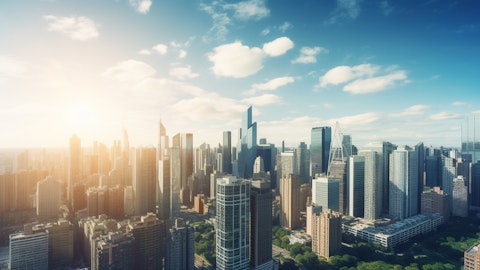In this article, we will talk about the 25 most futuristic cities in the US. You can also take a look at the 25 Most Technologically Advanced Cities in the World here.
The most futuristic cities in the US are leading the way in using new technologies to improve urban living. They are using Information and Communications Technologies (ICT), green energy, and smart infrastructure to build sustainable cities. These cities connect buildings, vehicles, and devices through IoT networks, promote electric vehicles, and use smart public transportation systems.
The push for green energy solutions like electric vehicles is important, as the United States Environmental Protection Agency reports that an average passenger vehicle emits approximately 4.6 metric tons of CO2 annually. This estimate is based on the assumption that the average gasoline-powered vehicle currently on the road achieves about 22.2 miles per gallon and travels around 11,500 miles per year. Each gallon of gasoline burned produces about 8,887 grams of CO2.
Recognizing the harmful effects of pollution, cities worldwide are moving towards sustainable solutions to protect the environment. According to Business Fortune Insights, the worldwide market for Green Technology and Sustainability is expected to increase from $19.76 billion in 2024 to $89.9 billion by 2032, with a compound annual growth rate (CAGR) of 20.9% throughout the forecast period.
The growth in green technology is driven by the increasing use of Green AI across various sectors. For instance, a data center can consume as much electricity as 50,000 homes, but Green AI enhances energy efficiency by adjusting cooling systems based on real-time data analysis. An example is Google’s DeepMind AI, which optimizes data center cooling by analyzing data from multiple sensors. This can help reduce energy consumption by up to 40%.
Furthermore, this growth is supported by key industry players developing sustainable solutions. Tesla, Inc. (NASDAQ:TSLA) is a popular example, producing electric vehicles and solar panels through its Tesla Energy Solutions division.
Here’s what Baron Funds said about Tesla, Inc. (NASDAQ:TSLA) in its Q1 2024 investor letter:
“Tesla, Inc. (NASDAQ:TSLA) designs, manufactures, and sells electric vehicles (EVs), related software and components, and solar and energy storage products. Shares fell 29.3% in the first quarter as the core automotive segment is facing headwinds due to a complex macroeconomic environment, factory shutdowns, growing competitive risks in China, and vehicle price reductions which are pressuring gross margins. During the first quarter of 2024, production was also negatively impacted by the Red Sea maritime supply[1]chain interferences, sabotage in a Tesla factory’s power supply in Berlin, and a factory closure for the launch of the refreshed Model 3. We remain shareholders. Tesla commenced delivery of its highly anticipated Cybertruck pickup, which features new technologies within the car and its manufacturing lines. Tesla also launched version 12 of its Full Self Driving product, which shows significant progress from prior versions and increases the probability that Tesla’s data collection at scale, and verticalized software and hardware approach will position Tesla as a leader in the future for autonomous driving and shared mobility. We also expect energy storage sales to continue to grow over the coming years as the adoption of renewable energy continues. Lastly, we believe Tesla’s core automotive segment will recover with the company remaining a leader in the EV market, which continues to expand with EVs still accounting for only around 10% of vehicle sales globally.”

An aerial view of a futuristic satellite hub in the sky, glowing in the night.
Our Methodology
To shortlist the 25 most futuristic cities in the US, we used a consensus methodology and consulted various sources such as Business Insider, BDC Network, Earth.Org, and WealthManagement.com. We collected information across various metrics related to sustainability, technology, and advanced infrastructure for each of the cities. Following the shortlisting of the cities, we assigned a score to each city based on the number of times it appeared across our sources. In the case of cities having the same score, tiebreaking was done on the basis of which city was outranking the other in our sources. The most futuristic cities in the US have been ranked in ascending order of their scores.
At Insider Monkey, we are obsessed with the stocks that hedge funds pile into. The reason is simple: our research has shown that we can outperform the market by imitating the top stock picks of the best hedge funds. Our quarterly newsletter’s strategy selects 14 small-cap and large-cap stocks every quarter and has returned 275% since May 2014, beating its benchmark by 150 percentage points. (see more details here).
25 Most Futuristic Cities in the US
25. Riverside, California
Score: 1
Riverside is an advanced city that encourages the use of electric vehicles by providing 357 public charging stations. Out of these, 55 are free EV charging stations. Moreover, the city has a solar PV capacity of 154.17 watts per capita, ranking 9th across the country. This increase in renewable energy production ensures a sustainable future for Riverside.
24. Orlando, Florida
Score: 1
Orlando has clean air with a pollution index of 34.9. Furthermore, the city has a low per capita carbon footprint of 14.7 ± 4.5, ensuring minimal greenhouse gas emissions that impact the environment negatively. This positive environmental impact ranks Orlando as the 24th most futuristic city.
23. Kansas City, Missouri
Score: 2
In Kansas City, approximately 69% of residents live within a 10-minute walk to a park, with 10% of the city’s land dedicated to parks and recreation. Kansas City has a low population density index of 32.50, which contributes to a less crowded urban environment. Moreover, the city has an air pollution index of 26.06, indicating relatively clean air and a healthier environment for its residents.
22. Tampa, Florida
Score: 2
Tampa is one of the least polluted cities, with a pollution index of 32.5. The city supports green transportation with 189 public EV charging stations. Moreover, Tampa has a relatively low per capita carbon footprint of 15.3 ±6.3, highlighting its commitment to sustainability.
21. Richmond, Virginia
Score: 2
Richmond, located on the banks of the James River, has approximately 128 EV charging stations distributed throughout the city. The city also has a low per capita carbon footprint of 20.3 ±10.9. Moreover, Richmond is rapidly improving its internet speed for development, increasing from 99.3 Mbps in 2022 to 124.1 Mbps in 2023, reflecting a 25% rise.
20. Philadelphia, Pennsylvania
Score: 2
Philadelphia proves itself as a futuristic city in several ways, with one leading aspect being its 29 B Corporations—businesses certified for high social and environmental standards. Popular B Corps in the city include Yikes, Inc., which focuses on web design, WordPress development, and web-based applications, and Arcweb Technologies, Inc., which builds custom digital products that add significant value for businesses.
19. San Antonio, Texas
Score: 2
San Antonio ranks prominently on several fronts. The city ranks 6th across the country with 166.08 watts of solar PV per capita and 5th with a total of 254.47 MW of installed solar PV capacity. Moreover, San Antonio supports electric vehicles with 204 EV charging stations distributed throughout the area. The city has a relatively low carbon footprint per capita of 15.2 ±4.9. San Antonio’s population index of 43.5 reflects its balanced urban development approach, making it a model for future-focused cities
18. Dallas, Texas
Score: 2
Dallas, located in North Texas, is home to 16 B Corporations. The city also supports green transportation with over 224 EV charging stations spread throughout the area.
17. Providence, Rhode Island
Score: 2
Providence maintains a relatively low air pollution index of 27.5. Moreover, 99% of the city’s residents can reach a park within a 10-minute walk, and 10% of its land is set aside for parks and recreation. Providence also ranks 3rd in the state for bike usage.
16. Salt Lake City, Utah
Score: 2
Salt Lake City ranks 2nd in the state for bike accessibility. The city is also advanced in electric vehicles, having 178 EV charging stations. Moreover, 82% of Salt Lake City’s residents can access a park within a 10-minute walk, and 8% of its land is dedicated to parks and recreation.
15. New York, NY
Score: 2
New York stands as one of the most advanced and populated cities in the US. The city hosts 79 B Corporations, including prominent marketing agencies like Influencer and Collective. With 23% of its land dedicated to parks and recreation, New York ensures that 99% of its residents live within a short walk to a park.
14. Minneapolis, Minnesota
Score: 2
Minneapolis has an extremely low pollution index of 29.3. About 99% of the city’s population lives within a 10-minute walk to the park, while 15% of the city’s land is dedicated to parks and recreation. Furthermore, the city has about 105 public EV charging stations, making it easy to use the vehicles within the city.
13. Raleigh, North Carolina
Score: 2
Raleigh, North Carolina, maintains a low population index of 30.9 and has a relatively modest per capita carbon footprint of 14.7 ±7.1. The city is equipped with over 148 EV charging stations.
12. Los Angeles, California
Score: 2
Los Angeles stands out as a highly futuristic city for several reasons. It is home to 102 B Corporations, indicating a strong presence of businesses committed to ethical practices. Los Angeles ranks 12th on our list of the most futuristic cities in the US.
11. Sacramento, California
Score: 2
Sacramento has over 342 EV charging stations and maintains a per capita carbon footprint of 14.2 ± 4.9. It is one of the most futuristic cities in the US with strong infrastructure for electric vehicles.
10. Las Vegas, Nevada
Score: 3
Las Vegas ranks as the 10th most futuristic city due to its low per capita carbon footprint of 12.3 ± 4.8 and 277 EV charging stations spread across the city.
9. Austin, Texas
Score: 3
Austin, the capital of Texas and one of its most populous cities has a pollution index of 42 and maintains a per capita carbon footprint of 15.0 ± 5.1. Moreover, Austin has one of the highest internet speeds, with the median download speed increasing from 115 Mbps in 2022 to 128.9 Mbps in 2023, marking a 12% rise.
8. San Jose, California
Score: 3
San Jose, California has 542 EV charging stations and a relatively low per capita carbon footprint of 17.5 ± 4.9. These factors demonstrate San Jose’s commitment to sustainable transportation and environmental responsibility.
7. Boston, Massachusetts
Score: 3
Boston, Massachusetts has a pollution index of 29.8. All residents enjoy access to parks within a 10-minute walk, with 18% of the city’s land dedicated to parks and recreation. Boston also features 494 EV charging stations, approximately 450 of which offer 24-hour charging services, supporting sustainable transportation initiatives.
6. Seattle, Washington
Score: 3
Seattle has a pollution index of 30.9, with over 99% of residents having access to a park within a 10-minute walk. Moreover, 12% of its land is dedicated to parks and recreation. Seattle also ranks 2nd in the state for the percentage of residents who commute by bike, highlighting its commitment to sustainable and active transportation options.
5. Denver, Colorado
Score: 3
With over 66 B Corporations Dever is known to be a highly futuristic city. The city gives its residents access to 337 charging stations. Added to this, 93% of Denver’s population has access to a park within a 10-minute walk, with over 10% of the city’s land covered by parks and recreation. Denver ranks 5th on our list of the most futuristic cities in the US.





